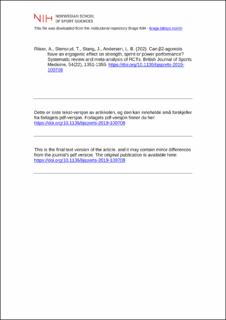| dc.contributor.author | Riiser, Amund | |
| dc.contributor.author | Stensrud, Trine | |
| dc.contributor.author | Stang, Julie | |
| dc.contributor.author | Andersen, Lars Bo | |
| dc.date.accessioned | 2021-02-10T08:10:47Z | |
| dc.date.available | 2021-02-10T08:10:47Z | |
| dc.date.created | 2020-11-16T11:52:48Z | |
| dc.date.issued | 2020 | |
| dc.identifier.citation | British Journal of Sports Medicine. 2020, 54(22), 1351-1359. | en_US |
| dc.identifier.issn | 0306-3674 | |
| dc.identifier.uri | https://hdl.handle.net/11250/2727056 | |
| dc.description | I Brage finner du siste tekst-versjon av artikkelen, og den kan inneholde ubetydelige forskjeller fra forlagets pdf-versjon. Forlagets pdf-versjon finner du på bjsm.bmj.com / In Brage you'll find the final text version of the article, and it may contain insignificant differences from the journal's pdf version. The definitive version is available at bjsm.bmj.com | en_US |
| dc.description.abstract | Objectives: We aimed to examine the effect of β2-agonists on anaerobic performance in healthy non-asthmatic subjects. Design: Systematic review and meta-analysis. Eligibility criteria: We searched four databases (PubMed, Embase, SPORTDiscus and Web of Science) for randomised controlled trials, published until December 2019, examining the effect of β2-agonists on maximal physical performance lasting 1 min or shorter. Data are presented as standardised difference in mean (SDM) with 95% confidence intervals (95% CI). Results: 34 studies were included in the present meta-analysis. The studies include 44 different randomised and placebo-controlled comparisons with β2-agonists comprising 323 participants in crossover trials, and 149 participants in parallel trials. In the overall analyses, β2-agonists improved anaerobic performance by 5% (SDM 0.29, 95% CI 0.16 to 0.42), but the effect was related to dose and administration route. In a stratified analysis, the SDM was 0.14 (95% CI 0.00 to 0.28) for approved β2-agonists and 0.46 (95% CI 0.24 to 0.68) for prohibited β2-agonists, respectively. Furthermore, SDM was 0.16 (95% CI 0.02 to 0.30) for inhaled administration and 0.51 (95% CI 0.25 to 0.77) for oral administration, respectively, and 0.20 (95% CI 0.07 to 0.33) for acute treatment and 0.50 (95% CI 0.20 to 0.80) for treatment for multiple weeks. Analyses stratified for the type of performance showed that strength (0.35, 95% CI 0.15 to 0.55) and sprint (0.17, 95% CI 0.06 to 0.29) performance were improved by β2-agonists. Conclusion/implication: Our study shows that non-asthmatic subjects can improve sprint and strength performance by using β2-agonists. It is uncertain, however, whether World Anti-Doping Agency (WADA)-approved doses of β2-agonists improve performance. Our results support that the use of β2-agonists should be controlled and restricted to athletes with documented asthma. | en_US |
| dc.language.iso | eng | en_US |
| dc.subject | doping | en_US |
| dc.subject | elite performance | en_US |
| dc.subject | respiratory | en_US |
| dc.title | Can β2-agonists have an ergogenic effect on strength, sprint or power performance? Systematic review and meta-analysis of RCTs | en_US |
| dc.type | Peer reviewed | en_US |
| dc.type | Journal article | en_US |
| dc.description.version | acceptedVersion | en_US |
| dc.source.pagenumber | 1351-1359 | en_US |
| dc.source.volume | 54 | en_US |
| dc.source.journal | British Journal of Sports Medicine | en_US |
| dc.source.issue | 22 | en_US |
| dc.identifier.doi | 10.1136/bjsports-2019-100708 | |
| dc.identifier.cristin | 1848284 | |
| dc.description.localcode | Institutt for idrettsmedisinske fag / Department of Sports Medicine | en_US |
| cristin.ispublished | true | |
| cristin.fulltext | postprint | |
| cristin.qualitycode | 2 | |
